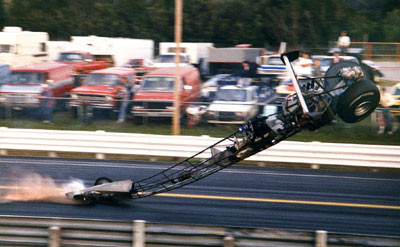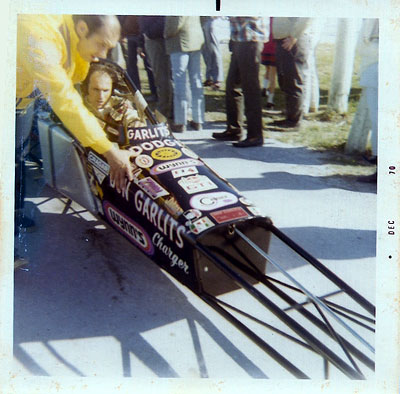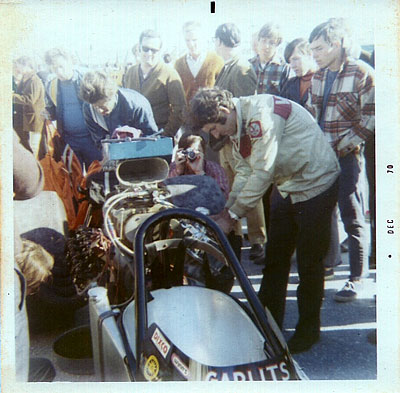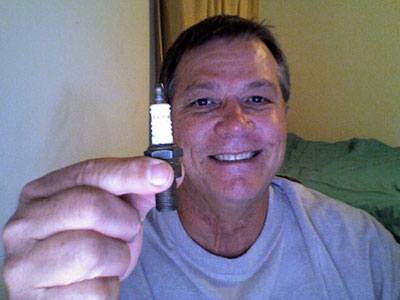

'I was there:' Garlits debuts Swamp Rat 14
 |
While watching the numbers on our '70s Top Fueler poll inch slowly toward the cutoff point (as opposed to the ‘70s Funny Car poll, which is skyrocketing toward that number; there's still time to vote in both if you scroll down a few articles), I got an interesting e-mail and photos from a longtime National DRAGSTER friend, Wade Nunnelly, who, as my feeble memory serves me, first came to my attention when he submitted photos of the wild blowover of the late Richard Holcomb at the 1988 Snowbird Nationals in Nunnelly’s homestate of Florida.
At the time, we hadn’t seen many blowovers beyond Don Garlits’ E-town jaw-dropper in Swamp Rat XXX in July 1986 and the destruction of Swamp Rat XXXI the next August in Spokane, Wash., and Nunnelly nailed a beautiful photo sequence of Holcomb’s car coming unglued. Holcomb’s car, tuned by the late, great Clayton Harris and featuring a narrowed rear end, had astounded everyone by becoming the third member of the Cragar Four-Second Club just two months earlier in Dallas, well in advance of better publicized and better financed drivers such as Joe Amato, Gary Ormsby, and reigning Top Fuel champ Dick LaHaie.
But I digress.
 |
 |
 |
Because Garlits’ revolutionary Swamp Rat 14 is a favorite in the '70s Top Fueler poll (both Garlits cars in the poll leapt out to an early lead, but the Ridge Route Terrors recently passed SR14 and apparently have their sights set on SR22, the 5.63 car), it’s an appropriate time to share Nunnelly’s “I was there” story about the first back-motored Swamp Rat’s initial test outings and the swell souvenir that Nunnelly walked away with.
As the flyer shown here depicts, the date was Dec. 27, and, as the photo borders attest, the year was 1970. The scene: Sunshine Speedway in St. Petersburg, Fla. Nunnelly was 15 years old, and enjoying his first experience with nitro. He got the flyer from a gas station, which is how he knew of the race.
Garlits had already made one private run at Tampa Dragway before he headed to St. Pete for the car’s public unveiling, and the work he had done to the car between – including adding a front airfoil -- clearly had paid off.
The car, as is evident here, was in its early stages with short body panels and not much more. It wasn't quite the machine that would debut the following January at Lions to the initial guffaws of the know-it-all Californians, whose smirks would soon turn to frowns following his dominating win at the NHRA Winternationals two weeks later.
According to Bob Post’s authoritative tome, High Performance, it was a 215-inch-wheelbase machine, the engine 20 inches out, and by moving components, Garlits and Connie Swingle achieved the desired 82-18 static balance Garlits thought ideal for the car.
According to Nunnelly’s records, Garlits turned a 7.01 211.92 on his first pass for a new track record, then went 6.85, 214.46 on the second run and shut off early on the last pass but still ran a 6.81.
“He went right down the track on clean runs with no tire smoke,” remembered Nunnelly. “On the third run, I remember standing at about the 1,000-foot mark and watching the chute coming out of the pack as he went by. My dad had arrived to give me a ride home, so we left immediately after the run. As you head back to Tampa, you have to go right past the end of the shutoff area. As we drove past, there was Garlits gathering up his chute. He had stopped about 50 feet from the gate at the end of the runoff.
“On the back of these pictures, I'd written notes," continued Nunnelly. “On the one with Jon Zorian (one of Garlits' machinists) pushing the car to the pits, it says that Gar is telling him, ‘I hit an oil slick about halfway down, and it started to slide, but it corrected nice and clean.' In two of the pics I didn't send you, Don is mixing fuel. The notes say on that first run, he ran 87 percent, and on the third run, he had a 97 percent load in it.”
Though Garlits ran a best of 6.80 at 220 mph, he thought that the car “was still a far cry from the beautiful-handling slingshot I was used to” because the car darted around on the top end, and Garlits kept overcorrecting.
It’s well-known that Garlits’ initial private-testing outings in the car were hindered by this spooky steering on the top end – an albatross that had hung around the neck of many a rear-engine project -- until “Big’s” ever-resourceful pal, Swingle, changed the steering ratio from a traditional 6:1 slingshot ratio to a more manageable 10:1. They drove home and made up some new steering parts, and the rest, as they say, is history.
They went to Orlando, Fla., shattered Don Prudhomme’s track record, and walked away giddily ready to beat the world. “We drove back from Tampa to Orlando that afternoon, and if anybody had been with us, they would have thought we were drunk,” wrote Garlits.
 |
But Nunnelly walked away with more than photos from his encounter with “Big Daddy.”
“While Garlits was working on the motor after the first run, he looked at a spark plug several times before tossing it on the ground behind him,” Nunnelly recalled. “Naturally, there was a big crowd around his pit, and it was funny seeing all those grown men looking at the plug but being too cool to pick it up. Then a small boy came forward and picked it up before I could get over there. I saw him in the pits later and bought it from him for a dollar. Years later, when I started bracket racing a dragster, I thought it would be my lucky charm, so I kept it in the pocket of my firesuit.”
And as to the obvious question? “Yeah, I still have it. It's an N-54R with two tiny blisters on the porcelain.”
Nunnelly, who was a great fishing buddy of our own Leslie Lovett, has since contributed his skills on many occasions to National DRAGSTER’s national event coverage throughout the years, but he still remembers how it all started for him, with just a little spark.

 |
Garlits' rear-engined car, of course, was not the first to be built nor even, some may argue, the first that was successful, but the photo files of longtime fans are filled with images of early attempts at mastering the back-motored mystery.
There are dozens of photos of these experimental machines floating around the 'Net, if you know where to look or belong to the right e-mail group. I received this one in my email last week, and find it a startling reminder about the inventiveness and bravery of the pioneers of our sport. Back in those early days, there was no idea too silly -- nor sometimes too dangerous -- to try, and each week's trip to the drags meant a journey into the unknown. You literally never knew what someone had dreamed up and hewn and cussed together in their garage since the previous weekend.
Some bemoan today's racing as boring due to the sameness of design in the top classes, and although rulesmakers, with a eye on safety and cost, certainly have limited what's possible, I'd guess it's also partially true that today's machines represent the pinnacle of what's possible with current technologies. Plus, with a lot more at stake today with million-dollar sponsorsorships, there's less incentive to stray off the well-proven path, but we'll always have the chance to look back at these sometimes-crude early machines and wonder if they ever thought they had reached the end game, and to be thankful that they hadn't.

“You’re killing us. Where is the all-of-the-above choice? This has got to be toughest [poll] of all, past or future.” -- Mike Macenka
“This is awful; at least eight cars are real favorites.” -- Alfredo Saldate
That was pretty much the sentiment I read, both in e-mail and on message boards, concerning our ‘70s Funny Car poll, which is what I expected. Although the voting is a little more lopsided than I would have thought, it’s clear that of any type of car in any decade, many fans of a specific ‘70s Funny Car are hard-core for their car.
There wasn’t a weak dog in the pack, and I’m surprised that the Pat Foster-driven Barry Setzer Vega hasn’t fared better given the almost universal love heaped on Foster and the car after Foster’s passing earlier this year. Though voting is not complete, it looks as if the "Jungle" man is going to win his second poll of the competition.

 |
While we’re on the topic of ‘70s Funny Cars, I’d like to take a moment to acknowledge the 30-year anniversary of the passing of ‘70s Funny Car fan favorite "Dodger" Glenn, known throughout the East Coast for his line of Frantic Ford cars. Glenn died as the result of a fire and crash at Maple Grove Raceway in 1978; Roger Mitchell, a hard-core Frantic Ford fan, notes that Glenn was driving the Frantic Arrow (“not the Frantic Ford as so many people state”) when he crashed.
“He never got a special issue of ND like [Eric] Medlen or [Scott] Kalitta did,” said Mitchell. “He didn't get squat, yet he was one of the finest Division 1 Funny Car drivers who ever lived.”
I can't undo the past from before my time here at ND, but here's a salute to Glenn and to all those who still keep his memory alive.
Coming Monday: The '80s and Beyond poll, which will set the field for the final Votedown to 1.



















































